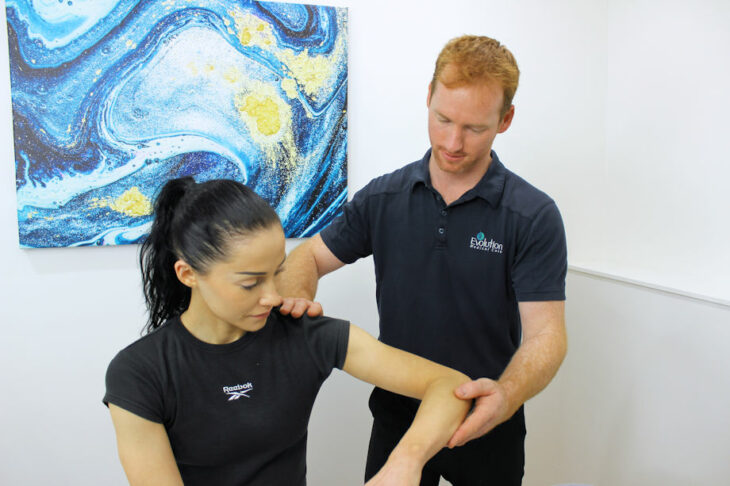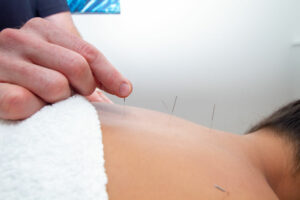We know Shoulder Bursitis is both a painful and restrictive condition to experience. If you have been suffering from Shoulder Bursitis or symptoms like it, then I am certain that you are fed up with it and want to know how to move around freely, without pain.
Did you know Shoulder bursitis is actually the most common form of bursitis?
This is due to the frequent use of this joint- and really, we use our shoulders a lot! the shoulder is also the joint with the most range of motion in the body- so naturally, the more movement and more frequency of movement is going to leave it susceptible to the most wear and tear.
If you have been suffering from shoulder pain and either know or suspect that you may have Shoulder Bursitis, keep reading because I am about to go into a lot more detail to cover:
- What is Shoulder Bursitis
- Causes and Symptoms of Bursitis
- How to Heal Shoulder Bursitis
What is Bursitis?
Bursitis is the terminology used to describe a bursa that is inflamed. Bursas are small fluid-like sacs, which are typically found around the body, where there are tendons or ligaments. These fluid-filled sacs help prevent friction between bones, muscles, tendons, and ligaments – a form of cushioning to stop them all from rubbing together and becoming irritated and inflamed.
The issue is that when TOO MUCH pressure is applied to a bursa through either repetitive movements, injuries like tears or dislocations or trauma, or even infection at times can actually contribute to inflammation of the bursa itself! We call this condition ‘Bursitis’.
Shoulder Bursitis Explained
Shoulder Bursitis is also sometimes referred to as rotator cuff tendonitis or a shoulder impingement. Shoulder Bursitis occurs when the bursas around the shoulder become aggravated. The bursas begin to swell and inflame, causing the development of scar tissue, in turn, causing the surrounding tendons and muscles to swell and elicit a painful sensation.
For many sufferers of Shoulder Bursitis, range of movement is also impacted which may result in a decreased ability to move both the shoulder and arm, and this really restricts our ability to perform a variety of simple movements – think combing your hair, reaching for a food item above shoulder height on a supermarket shelf. Any movement of the shoulder can become painful, and let’s face it- we use our arms and shoulders a lot!
Lots of patients that I see at the clinic with shoulder bursitis commonly report having trouble:
- Getting dressed in the morning
- Playing sports- particularly golf or tennis. Tennis players have difficulty with the serve due to the high engagement of the ball and racket
- Driving a car. This is extremely important for so many people’s independence-whether that be working or attending social events.

Now, if you have been dealing with Shoulder Bursitis, I cannot emphasise more strongly to take action to resolve this issue. Simply put, the longer that you have Shoulder Bursitis, the harder (and more expensive) it is to treat and achieve lasting results.
If treated appropriately, Shoulder Bursitis is very manageable and many patients that I work with achieved complete recovery without any ongoing pain. Many of our patients LOVE having the return of their shoulder range of motion so that they can get back to simple everyday tasks PAIN-FREE! My patient, Geoff was telling me that the single biggest thing that he appreciated about resolving his shoulder pain was that he could, at last, get back to walking his Rottweiler which was a significant pastime for him.
Causes of Shoulder Bursitis
Shoulder bursitis can be caused through a variety of reasons, however, it is most commonly caused by overuse of the shoulder joint. This is generally with repetitive tasks performed overhead or in high volume: think lifting a box from a shelf over head height, or painting a ceiling.
Individuals who suffer from diabetes, kidney disease, thyroid disease, rheumatoid arthritis, arthritis, or gout may be more susceptible to the development of Shoulder Bursitis. Bursitis also becomes more common with increased age, sporting activities and the style of work performed.
Did You Know There Are 5 Bursas That Help Support The Sholder Joint Alone?
The Five Main Bursas Surrounding the Shoulder (which can all become inflamed) include:
- Subacromial-Subdeltoid (SASD) Bursa
- Subscapular Recess – Subscapularis Bursa
- Subcoracoid Bursa
- Coracoclavicular Bursa
- Supra-acromial Bursa
Typically bursitis will inflame just a single bursa, however, it could affect multiple bursae at once.

The Most Common Types of Shoulder Bursitis
The most common form of bursitis of the shoulder is subacromial bursitis. This helps with movement when the arm is elevated above the head. The subacromial bursa is the largest of the bursas in the shoulder and is located at the tip of the shoulder.
The severity of Shoulder Bursitis changes the symptoms that individuals may experience. Generally, there are three types of bursitis:
1. Chronic
The most common symptom associated with chronic bursitis is localised swelling. Individuals on rare occasions may also have a slight redness associated with the swelling or slight discolouring. This form of bursitis may become painful and warm to the touch. Many individuals will adapt to the pain, and learn how to manage it, although when left untreated, it can cause pain to surrounding areas like the elbow, arm, or neck. The other joints such as the elbow, arm and neck will become painful in chronic conditions as these joints are compensating due to lack of movement in the shoulder and often extend, and overstretch in actions they just shouldn’t be regularly doing.
2. Infection
Warmth experienced with bursitis can indicate an infection. Symptoms would include a slight fever, tenderness, and pain around the shoulder. On occasion, redness and swelling from the site may also refer down the arm. It’s also not uncommon to experience tiredness and become physically ill. Bacterial infections like staph infections could lead to septic of the bursa in the shoulder. If you do experience these symptoms, seek medical assistance immediately.
3. Traumatic
This type of bursitis has a very rapid onset and will create localised swelling immediately. Typically, this occurs in sporting injuries. The area may become warm and tender, accompanied by bruising and swelling.
It is often hard to differentiate between chronic and infected bursitis, even though symptoms will often point to one type of bursitis over another. Individuals who are suffering from fever and redness should seek medical assistance, as this is more likely to be associated with an infected or traumatic form of bursitis. More often than not Shoulder Bursitis is a chronic condition.
How to Identify Shoulder Bursitis
Unsure if your shoulder pain is Shoulder Bursitis? There are three methods to formally diagnose Shoulder Bursitis. These are:
- Ultrasound or MRI – either of these methods are performed to detect any inflammation in the bursae
- X-rays – these are used to eliminate other factors that may be causing similar symptoms, such as bone spurs or arthritis. X-rays are also used to detect calcification within the bursa; which happens when bursitis is reoccurring or has become chronic.
- Joint aspiration – this is where the bursa is drained, which could be a small sample of fluid or almost the entire bursa. This fluid is then tested to rule out things like gout or infection.
When Shoulder Bursitis is diagnosed but left untreated, the ongoing inflammation leads to weakness in both the shoulder and arm. Left untreated, bursitis may result in enlargement and thickening of the impacted bursa – on occasion, this may become permanent. This will lead to a reduction in the range of movement of the shoulder and further pain with activity.
In addition to this, when left untreated, muscle weakness develops due to a long-term reduction of joint use, the common ‘if you don’t use it, you lose it’ scenario. This only makes the situation worse as now not only do you have to reduce inflammation but build up strength in the shoulder to prevent relapse of the condition!
How to Help Shoulder Bursitis?
Now, as with all things, there are lots of ways to improve outcomes and some are naturally better than others.
There are definitely some methods that you can use at home to assist with relieving symptoms related to Shoulder Bursitis. These include:
- reducing shoulder movement
- ice packs and
- even some nonsteroidal anti-inflammatory drugs and other pain medications can help in the short term.
These methods are all known to ease swelling and pain which are commonly associated with Shoulder Bursitis.
You can also opt for non-surgical treatments, which may include the use of steroid injections into the bursa to further reduce swelling and pain which at times may provide relief for several months. If the Shoulder Bursitis is due to infection then a common course of treatment is to use antibiotics which is an appropriate course of action for this scenario.
When it comes to Shoulder Bursitis, surgery is rarely required in order to resolve the situation
Natural Therapies For Shoulder Bursitis
As with all situations, I always recommend starting with non-invasive options first. Most painful situations, whether they be acute or chronic respond extremely well to Natural Therapies like Acupuncture, TENS Therapy, Electro-Acupuncture, Remedial Massage, Cupping Therapy, Trigger Point Therapy, Laser Therapy and Auriculotherapy.
As you can see, there are various natural therapies that can be used to improve symptoms related to Shoulder Bursitis. One natural therapy that we receive lots of positive feedback about is Acupuncture.
Acupuncture is so popular because it can be used to help individuals suffering from both chronic or acute pain associated with bursitis. Acupuncture helps increase local blood circulation, which has an impact to reduce pain and swelling associated with bursitis and improve shoulder range of movement to help sufferers get back to what they love doing most.

Ready to Say Goodbye to Shoulder Bursitis?
The single most important factor in getting lasting relief from Shoulder Bursitis is to apply an effective recovery plan. Without it, results will be short-lived and symptoms will come back all too quickly, which is exactly what pain sufferers dislike the most.
When it comes to developing an effective recovery plan, it’s paramount to see a therapist like an Acupuncturist that is skilled in:
- Performing key physical assessment techniques to diagnose exactly what type of shoulder pain you are experiencing and why this has developed (causes may vary significantly!!!)
- Applying best practice treatment protocols that actually get results fast and provide ongoing relief
- Understanding WHY you developed this pain and implementing lifestyle advice to help prevent this condition from ever coming back again.
If you are looking for assistance with Shoulder Bursitis, please call our friendly team on (02) 4709 6727 to learn more about how we can help, or simply book online now to secure an appointment time so we can help you get started!





